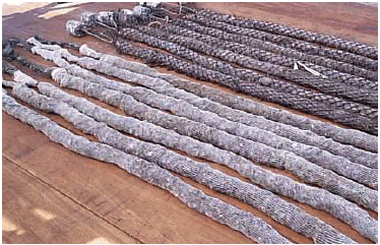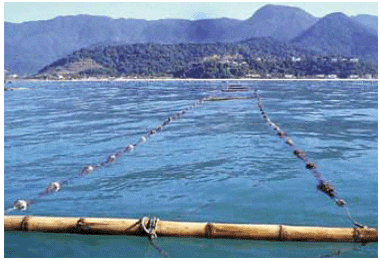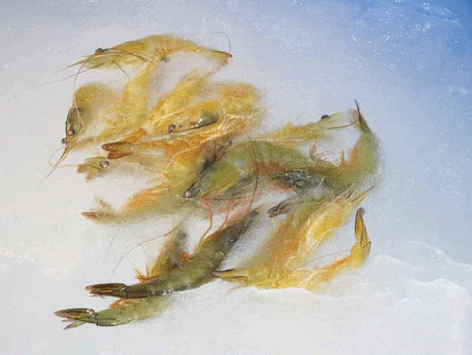The use of buoys to keep collectors at the air-water interface doubled seed volume. A modified Spanish seeding system using cotton socks and ropes made of discarded nets reduced seeding time by 30 per cent in comparison to the French system. Stocking density could be reduced by half without decreases in productivity or the mean weight of mussels.
According to the Food and Agriculture Organization of the United Nations, Brazil is the second-largest producer of mussels in South America. The country produced 13,723 mt in 2010, mostly in the states of Santa Catarina and Paraná. Other states, including São Paulo, produced a total of 450 mt.
Mussel farming is carried out mainly by small producers, and particularly in São Paulo, it is conducted in a semi-artisanal way. The operations of mussel seed socking and mussel harvesting and cleaning are done manually or using rudimentary equipment. Therefore, labor represents a significant portion of the total costs of production.
Seedstock, Supply Issues
In Brazil, as in most tropical countries, mussel seed is not a plentiful resource due to continuous non-intensive reproductive activity throughout the year. Uptake of mussel seed on artificial collectors in São Paulo state occurs only in spring and, in some years, autumn.
The amount of seed obtained is quite variable from year to year due to climatic variations and occasional warm water flows in summer that cause seed mortality. The production of seed in hatcheries could be a solution to this problem, but producers will have to take into account the costs of acquisition, transport and handling of the seed.
Seed collectors are placed horizontally parallel to the sea surface to allow the uptake of seed. Consequently, they occupy a wide area that could be used to increase mussel production. Presently, each 1,000 m2 of growing area requires an additional 500 m2 for the placement of collectors.

Finally, the use of seed collectors has costs, mainly in labor. Observations have shown that the labor necessary for manufacturing the collectors, transport and placement on the sea, and removal and handling of seed in the socks, accounts for more than 50% of the total cost of labor in mussel production.

Seed Collectors
The authors recently conducted research in Cocanha Beach, Caraguatatuba, São Paulo, Brazil, to improve the uptake of seed in artificial collectors and optimize the amount of seed used in mussel farming without affecting the final yield through reduction of seeding density and modification of the seed sock system.
Seed collectors used in mussel farming in São Paulo are typically made of braided discarded nets with variable length. As a rule, these collectors remain submerged for five months, after which seed is removed and transplanted to mussel socks.
Research showed that the use of small buoys to keep the collectors placed horizontally at the air-water interface doubled the number of collected seed in the same period of time. These results stimulated the use of artificial collectors, and the higher amount of seed collected has mitigated the variability in seed collected from year to year.

Producers generally use two types of collectors: individual 2-m-long collectors and continuous collectors with length varying from 10 to 50 m. Transplanting of seed to grow out socks only occurs if uptake is intense. Otherwise, mussel seed is kept in the collectors until reaching a marketable size over 6 cm in length. Commercial “Christmas tree” collectors are not used due to their high cost and the abundance of discarded material that can be used in the manufacture of artisanal collectors.
Seed Density Reduction
Traditionally in São Paulo, producers have adopted a seeding density of around 500 seed/m of sock using the French system of seeding in cotton socks inside polyethylene tubular nets. Research showed that this number can be reduced to 300 seed/m without any decrease in productivity or mean weight of mussels. Future research will evaluate the influence of density on the condition index of farmed mussels.
Other studies verified the technical and economic feasibility of replacing the French system of seeding by a modified Spanish system, using cotton socks involving the mussel seed in ropes made of braided discarded nets. The modified Spanish system provides greater economy in material, and the time spent in seeding the ropes is about 30% lower than for the French system. Thus, this has been the system preferred by producers for some time.
Presently, new research is under way to further reduce the density of seed. It was observed that it is possible to use as few as 200-250 seed/m of rope without reducing the final yield. At low densities, survival of the mussels is higher because the mussels remain firmly attached to the ropes and avoid detachment. In French systems or Spanish systems at higher densities, the mussels often attach to each other, and detachment is easer, increasing losses.
Perspectives
The authors believe that reduction in seeding density in mussel farming promotes lower labor costs for manufacturing seed collectors and handling seed mussels, as well as a reduced requirement for seed collection areas. Less space for seed collection corresponds to more space for mussel production.
The emergence of additional mussel seed produced in hatcheries or on artificial collectors helps increase the value of this resource. The results of these studies will allow the expansion of culture without increasing the demand for seed, improving economic profitability and enhancing the sustainability of the mussel sector as a whole.
July 2013
